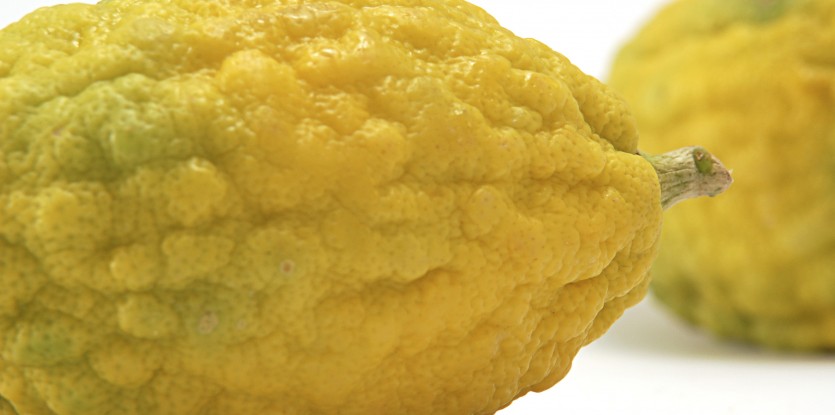“You shall take for yourselves, on the first day [of Sukkot],” instructs the Torah in the 23rd chapter of Leviticus, “the magnificent fruit of a tree, the frond of a date-palm, branches from the thick-leaved tree, and willows of the brook.”
These are the familiar “four kinds”–the etrog (citron), lulav (palm frond), hadassim (myrtle twigs) and aravot (willow twigs)–that play a central role in the observances of Sukkot.
The Torah, however, does not explicitly name the four kinds, identifying them instead through allusions and double-entendres.[1] The Talmud reads the phrase pri etz hadar (“the magnificent fruit of a tree”) as a reference to the etrog, since the Hebrew word hadar (“magnificent”) can also be read ha-dar, “that which dwells,” so that the phrase also translates as “the fruit that dwells on its tree from year to year.” Unlike other fruits, which wither and fall off after a single season, the etrog continues to grow on its tree throughout the year, seemingly unaffected by the annual cycle.
Weathering Change
The year is a microcosm of life. The bud and bloom of youth, the fruitfulness of maturity, the autumn of one’s later years, the wither of winter—all find expression in its seasons. The year includes mundane workdays and holy Shabbatot; masculine solar cycles and feminine lunar ones; and, of course, the moadim, the “appointments in time” that the festivals represent, each a fountainhead of its particular quality–freedom on Passover, joy on Sukkot, etc. The year incorporates the full spectrum of human experience; the next year can only repeat its cycles and phases, albeit on the higher elevation of accumulated acumen and achievement.
The year embodies all changes and transitions of life, which each annual cycle repeats.
Hence the Hebrew word for “year,” shanah. Shanah means both “change” and “repetition”: the year embodies all changes and transitions of life, which each annual cycle repeats.
This is the deeper significance of the Torah’s description of the etrog. The etrog, which represents the magnificence of the tzaddik, the perfectly righteous individual,[2] is one who “dwells in his tree from year to year”: one who weathers all changes and fluctuations, whose integrity, growth and connection with his source are not compromised by any of life’s vacillations.
Based on the Rebbe’s notes in a journal entry dated Chanukah 5696 (1935)[3]
_______________________________________________________
[1] “The magnifiscent fruit of a tree” is the etrog as elaborated below; the myrtle is identified only as “the thick-leaved tree”; and while lulav’s tree is identified outright, not every palm frond qualifies as a lulav: our sages derive from the verse that it refers to the unopened fronds at the very top of the palm. Only the willow is explicitly identified.
[2] See Midrash Rabbah, Vayikrah 30:12.
[3] Reshimot #3, p. 17.







